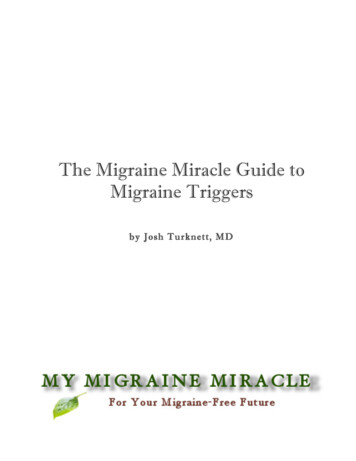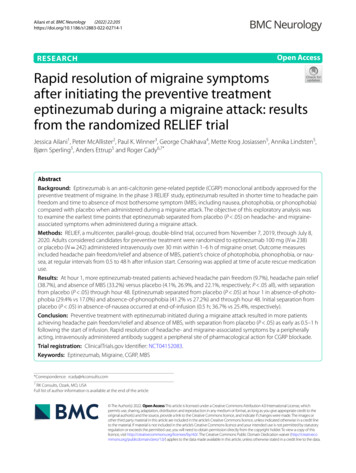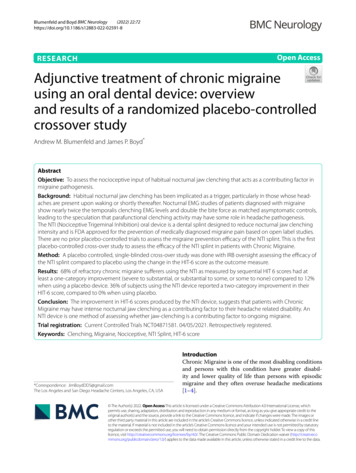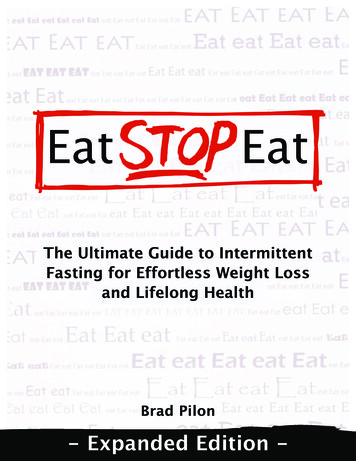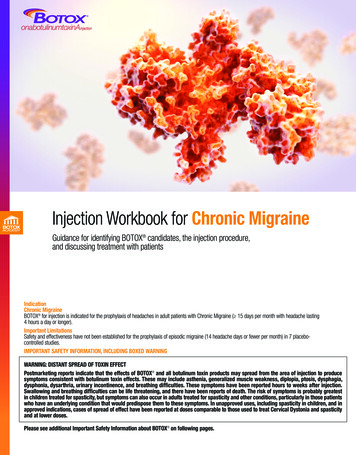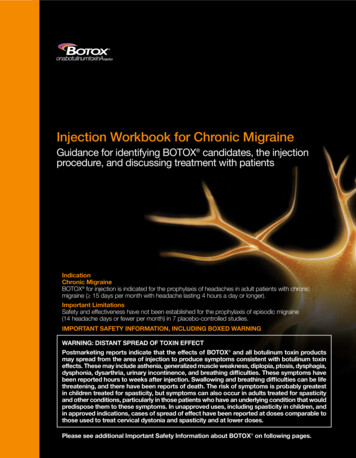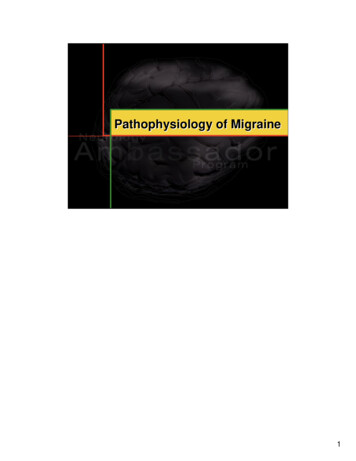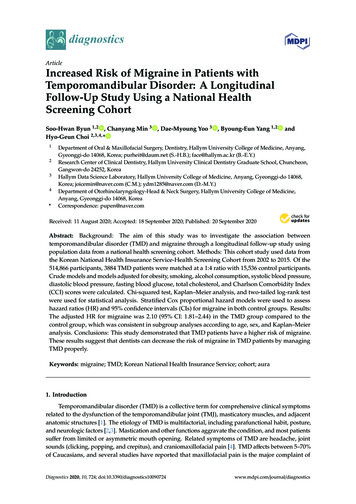
Transcription
diagnosticsArticleIncreased Risk of Migraine in Patients withTemporomandibular Disorder: A LongitudinalFollow-Up Study Using a National HealthScreening CohortSoo-Hwan Byun 1,2 , Chanyang Min 3 , Dae-Myoung Yoo 3 , Byoung-Eun Yang 1,2Hyo-Geun Choi 2,3,4, *1234*andDepartment of Oral & Maxillofacial Surgery, Dentistry, Hallym University College of Medicine, Anyang,Gyeonggi-do 14068, Korea; purheit@daum.net (S.-H.B.); face@hallym.ac.kr (B.-E.Y.)Research Center of Clinical Dentistry, Hallym University Clinical Dentistry Graduate School, Chuncheon,Gangwon-do 24252, KoreaHallym Data Science Laboratory, Hallym University College of Medicine, Anyang, Gyeonggi-do 14068,Korea; joicemin@naver.com (C.M.); ydm1285@naver.com (D.-M.Y.)Department of Otorhinolaryngology-Head & Neck Surgery, Hallym University College of Medicine,Anyang, Gyeonggi-do 14068, KoreaCorrespondence: pupen@naver.comReceived: 11 August 2020; Accepted: 18 September 2020; Published: 20 September 2020 Abstract: Background: The aim of this study was to investigate the association betweentemporomandibular disorder (TMD) and migraine through a longitudinal follow-up study usingpopulation data from a national health screening cohort. Methods: This cohort study used data fromthe Korean National Health Insurance Service-Health Screening Cohort from 2002 to 2015. Of the514,866 participants, 3884 TMD patients were matched at a 1:4 ratio with 15,536 control participants.Crude models and models adjusted for obesity, smoking, alcohol consumption, systolic blood pressure,diastolic blood pressure, fasting blood glucose, total cholesterol, and Charlson Comorbidity Index(CCI) scores were calculated. Chi-squared test, Kaplan–Meier analysis, and two-tailed log-rank testwere used for statistical analysis. Stratified Cox proportional hazard models were used to assesshazard ratios (HR) and 95% confidence intervals (CIs) for migraine in both control groups. Results:The adjusted HR for migraine was 2.10 (95% CI: 1.81–2.44) in the TMD group compared to thecontrol group, which was consistent in subgroup analyses according to age, sex, and Kaplan–Meieranalysis. Conclusions: This study demonstrated that TMD patients have a higher risk of migraine.These results suggest that dentists can decrease the risk of migraine in TMD patients by managingTMD properly.Keywords: migraine; TMD; Korean National Health Insurance Service; cohort; aura1. IntroductionTemporomandibular disorder (TMD) is a collective term for comprehensive clinical symptomsrelated to the dysfunction of the temporomandibular joint (TMJ), masticatory muscles, and adjacentanatomic structures [1]. The etiology of TMD is multifactorial, including parafunctional habit, posture,and neurologic factors [2,3]. Mastication and other functions aggravate the condition, and most patientssuffer from limited or asymmetric mouth opening. Related symptoms of TMD are headache, jointsounds (clicking, popping, and crepitus), and craniomaxillofacial pain [4]. TMD affects between 5–70%of Caucasians, and several studies have reported that maxillofacial pain is the major complaint ofDiagnostics 2020, 10, 724; l/diagnostics
Diagnostics 2020, 10, 7242 of 11more than half of the consultations and up to 80% of dental appointments among adolescents [5,6].Moreover, it was shown that clinicians feel incompetent in managing TMD, resulting in referrals toother clinicians [7].Migraine usually occurs on one side of the head with throbbing pain or a pulsing sensation.The symptoms often occur with photosensitivity, vomiting, and nausea. Migraine can last for severalhours, and it can interfere with normal activities. Medications could relieve some migraines andprevent them. Proper medications, combined with self-help solutions and healthier lifestyles, mighthelp to manage this headache [8].The International Classification of Headache Disorders (ICHD) has classified migraine into twotypes: with and without aura [9]. Based on the classification of ICHD-3, an aura must present withat least three of the following six symptoms: spreading gradually for more than 5 min, two or moresymptoms occurring in succession, each individual aura symptom lasts 5–60 min, at least one aurasymptom is unilateral, at least one aura symptom is positive, and the aura is accompanied or followedwithin 60 min by headache [9,10]. An aura is known as a warning sign prior to migraine for somepatients. An aura can occur with visual disturbances, including blind spots, flashes of light, tingling onone side of the face, or difficulty speaking. Migraine with aura is considered to affect between one-fifthand one-third of those with migraine in the United States, an estimated 7.4–11.1 million people [11].The pathophysiology of aura is widely known as cortical spreading depression (CSD) [12]. CSD isactivated by slow depolarization in cortical neurons and glia, followed by hyperpolarization that movesacross the cortex at a rate of 3–5 mm/min. It is accompanied by alterations in neurotransmitter releaseand ion homeostasis [13]. As greater energy is needed to restore homeostasis, this is accompanied by arapid spike in cerebral blood flow [14].A migraine without aura is the most common type of migraine, comprising approximately 75%of all migraines [9]. This type of migraine develops without aura, but it can present with varioussymptoms at its initial stages. According to ICHD-3, it lasts for 4–72 h and has at least two of thefollowing headache characteristics: moderate-to-severe intensity, unilateral location, aggravation byphysical activity, and pulsating quality [15]. One or more associated symptoms such as nausea/vomitingand photophobia/phonophobia would happen during the attack. In addition, attacks of a migrainewithout aura must not be attributable to another disorder.Most painful symptoms are transient and are related to a specific lesion or disease that canbe cured. Unfortunately, some types of pain are chronic, and chronic pain remains a public healthissue [16]. Both TMD and migraine could be main causes of chronic pain in the orofacial area. Manypatients with TMD have several comorbid conditions [17,18]. Moreover, previous studies of TMDpatients have revealed that comorbid conditions are the reason for 50% of TMD patients requiring carefor TMD symptoms, and for 20% of patients with long-term disability from their pain [19–21]. It isessential that any comorbid conditions and their influences on clinical outcomes are identified andevaluated by clinicians managing TMD patients [22].Some studies have reported an association between TMD and migraine [8,23–26]. This associationwas thought to be induced by anatomic, neurologic, and emotional relationships. Previous studiesreported that migraine is related to pain in the sinus, teeth, TMJ, and cervical areas [27–29]. However,most studies have been based on limited participants or subjective questionnaires [26,30].The aim of this study was to investigate the association between TMD and migraine by conductinga longitudinal study using population data from a national health screening cohort. It was determinedthat patients with TMD have a greater risk of migraine than those without TMD.2. Materials and Methods2.1. Study PopulationThe ethics committee of Hallym University approved this study on 4 November 2019(No. 2019-10-023). The need for written informed consent was waived by the Institutional Review Board.
x FOR PEER REVIEWDiagnostics 2020, 10, 7243 of 11Korean National Health Insurance Service-Health Screening Cohort data have been describedAllanalyses[31].adhered to the guidelines and regulations of the ethics committee. The details of the KoreanelsewhereNational Health Insurance Service-Health Screening Cohort data have been described elsewhere [31].2.2. Definition of Temporomandibular Disorder2.2. Definition of Temporomandibular DisorderTMD was defined if participants were diagnosed with the ICD (International Classification ofTMD was defined if participants were diagnosed with the ICD (International Classification ofDiseases)-10 code K07.6 (Temporomandibular joint disorders). For diagnostic accuracy, this studyDiseases)-10 code K07.6 (Temporomandibular joint disorders). For diagnostic accuracy, this study onlyonly selected participants who were treated 2 times for the diagnosis of TMD.selected participants who were treated 2 times for the diagnosis of TMD.2.3. Definition of Migraine2.3. Definition of MigraineMigraine was defined if participants were diagnosed with the ICD-10 code G43 (Migraine). ForMigraine was defined if participants were diagnosed with the ICD-10 code G43 (Migraine).diagnostic accuracy, this study only selected participants who were treated 2 times for the diagnosisFor diagnostic accuracy, this study only selected participants who were treated 2 times for theof migraine. Among them, migraine with aura was defined if participants were diagnosed with thediagnosis of migraine. Among them, migraine with aura was defined if participants were diagnosedICD-10 code G43.1 (Migraine with aura).with the ICD-10 code G43.1 (Migraine with aura).2.4. Participant2.4.Participant SelectionSelectionTMD desfromfrom2002to2015(n enotdiagnosed2002 to 2015 (n 4627). The control group consisted of participants who were not diagnosed with TMDwith TMDfrom2002to 510,239).2015 (n 510,239).TMD werepatientswere excludedif theyhad awashout1-year washoutfrom2002 to2015(n TMD patientsexcludedif they hada 1-yearperiodperiod(n Control 172). Controlparticipantswere excludedif theywere diagnosedwith theICD-10(n 172).participantswere excludedif they werediagnosedwith the ICD-10codeK07.6 codeonceK07.6once(n participantsforage,sex,(n 6659). TMD patients were matched at a 1:4 ratio with control participants for age, sex, omlytopreventselectionbias.Inthisstudy,weand region of residence; this was done randomly to prevent selection bias. In this study, we supposedsupposedthat thematched participantswereinvolvedin (indexthe samedate(index date).thatthe matchedparticipantswere involvedin thesame datedate).ParticipantswhoParticipantsdied rainebeforetheindexdatewereexcluded.the index date and had a history of migraine before the index date were excluded. In 1 participants were excluded, and during matching, 488,044 control participants were excluded.wereexcluded.As a patientsresult, 3884patientswereat acontrol1:4 ratiowith 15,536controlAsa result,3884 TMDwereTMDmatchedat a 1:4ratiomatchedwith 15,536participants(Figure1).participants (Figure 1).Figure1. AA schematicschematic illustrationillustration ofof thethe participantparticipant selectionselection process.process. OutOut ofof 514,866514,866 participants,participants, 38843884Figure 1.patients with temporomandibular disorder were matched at a 1:4 ratio with 15,536 control participantspatients with temporomandibular disorder were matched at a 1:4 ratio with 15,536 controlfor age, sex, income, and region of residence. TMD, temporomandibular disorder; ICD-10, Internationalparticipants for age, sex, income, and region of residence. TMD, temporomandibular disorder; ICDClassification of Diseases, 10th edition.10, International Classification of Diseases, 10th edition.
Diagnostics 2020, 10, 7244 of 112.5. CovariatesAge was categorized into ten groups ranging from 40–44 to 85 . Income groups were dividedinto five classes from lowest income (class 1) to highest (class 5) income. Regions of residence weregrouped into urban and rural areas following our previous study [31].Tobacco smoking, alcohol consumption, obesity based on body mass index (BMI, kg/m2 ) [32,33],systolic blood pressure (BP), diastolic BP, fasting blood glucose, and total cholesterol were measured asdescribed in our previous study [34]. The Charlson Comorbidity Index (CCI) was used to measure17 comorbidities [35].2.6. Statistical AnalysesChi-squared tests were used to compare general characteristics between the TMD andcontrol groups.Stratified Cox proportional hazard models were used to assess the hazard ratios (HRs) and 95%confidence intervals (CIs) for migraine in the TMD group compared to the control group. In thisanalysis, crude (simple) and adjusted (for obesity, smoking, alcohol consumption, systolic BP, diastolicBP, fasting blood glucose, total cholesterol, and CCI scores) models were used. Age, sex, income,and region of residence were stratified. Additionally, this study calculated HRs with 95% CIs formigraine with and without aura in the TMD group compared to the control group.A Kaplan–Meier analysis and the log-rank test were used to analyze the cumulative probability ofmigraine in the TMD group compared to the control group.For subgroup analyses, this study divided participants by age and sex ( 60 years old and 60 yearsold; males and females) and analyzed the crude and adjusted models. We additionally performedsubgroup analyses of crude and adjusted HRs for migraine with and without aura in the TMD groupcompared to the control group (Tables S1 and S2).Two-tailed analyses were performed, and significance was defined as p-values less than 0.05. SASversion 9.4 (SAS Institute, Cary, NC, USA) was used for statistical analyses.3. ResultsThe general characteristics for age, sex, income, and region of residence were identical due tomatching between the groups (Table 1), while those for obesity, smoking, alcohol consumption, BP,fasting blood glucose, total cholesterol, and CCI were different.Table 1. General characteristics of participants.Total ParticipantsCharacteristicsAge (years �7475–7980–8485 TMD (n, %)Control (n, %)128 (3.3)403 (10.4)626 (16.1)629 (16.2)538 (13.9)595 (15.3)512 (13.2)319 (8.2)107 (2.8)27 (0.7)512 (3.3)1612 (10.4)2504 (16.1)2516 (16.2)2152 (13.9)2380 (15.3)2048 (13.2)1276 (8.2)428 (2.8)108 (0.7)p-Value1.000
Diagnostics 2020, 10, 7245 of 11Table 1. Cont.Total ParticipantsCharacteristicsSexMaleFemaleIncome1 (lowest)2345 (highest)Region of residenceUrbanRuralObesity †UnderweightNormalOverweightObese IObese IISmoking statusNon-smokerPast smokerCurrent smokerAlcohol consumption 1 time a week 1 time a weekSystolic blood pressure 120 mmHg120–139 mmHg 140 mmHgDiastolic blood pressure 80 mmHg80–89 mmHg 90 mmHgFasting blood glucose 100 mg/dL100–125 mg/dL 126 mg/dLTotal cholesterol 200 mg/dL200–239 mg/dL 240 mg/dLCCI score0123 4Migraine with/without auraMigraine without auraMigraine with auraTMD (n, %)Control (n, %)1753 (45.1)2131 (54.9)7012 (45.1)8524 (54.9)598 (15.4)505 (13.0)626 (16.1)800 (20.6)1355 (34.9)2392 (15.4)2020 (13.0)2504 (16.1)3200 (20.6)5420 (34.9)1908 (40.1)2850 (59.9)7632 (40.1)11,400 (59.9)112 (2.9)1530 (39.4)1104 (28.4)1056 (27.2)82 (2.1)385 (2.5)5601 (36.1)4171 (26.9)4885 (31.4)494 (3.2)2923 (75.3)485 (12.5)476 (12.3)11443 (73.7)1738 (11.2)2355 (15.2)2733 (70.4)1151 (29.6)10,892 (70.1)4644 (29.9)1292 (33.3)1882 (48.5)710 (18.3)4704 (30.3)7508 (48.3)3324 (21.4)1964 (50.6)1355 (34.9)565 (14.6)7306 (47.0)5540 (35.7)2690 (17.3)2540 (65.4)1044 (26.9)300 (7.7)9787 (63.0)4297 (27.7)1452 (9.4)2108 (54.3)1294 (33.3)482 (12.4)8288 (53.4)5115 (32.9)2133 (13.7)2630 (67.7)582 (15.0)337 (8.7)149 (3.8)186 (4.8)263 (6.8)253 (6.5)10 (0.3)10,594 (68.2)2254 (14.5)1206 (7.8)633 (4.1)849 (5.5)507 (3.3)476 (3.1)31 (0.2)p-Value1.0001.0001.000 0.001 * 0.001 *0.754 0.001 * 0.001 *0.001 *0.0970.138 0.001 * 0.001 *0.482CCI, Charlson Comorbidity Index; TMD, temporomandibular disorder. * Chi-squared test, significance at p 0.05.† Obesity (body mass index, kg/m2 ) was categorized as underweight ( 18.5), normal ( 18.5 to 23), overweight( 23 to 25), obese I ( 25 to 30), or obese II ( 30).The adjusted HR for migraine was 2.10 (95% CI: 1.81–2.44) in the TMD group compared to thecontrol group (Table 2). The results were consistent in subgroup analyses according to age and sex.These were also exhibited in the Kaplan–Meier analysis (Figure 2).
Diagnostics 2020, 10, 7246 of 11Table 2. Crude and adjusted hazard ratios (95% confidence interval) for migraine in temporomandibulardisorder and control groups.Hazard Ratios for MigraineCharacteristicsCrude †Total participants (n 19,420)TMD2.12 (1.83–2.46)Control1.00Age 60 years old, men (n 4040)TMD2.07 (1.34–3.19)Control1.00Age 60 years old, women (n 4890)TMD1.92 (1.49–2.48)Control1.00Age 60 years old, men (n 4725)TMD2.24 (1.55–3.22)Control1.00Age 60 years old, women (n 5765)TMD2.30 (1.80–2.93)Control1.00p-ValueAdjusted †,‡p-Value 0.001 *2.10 (1.81–2.44)1.00 0.001 *0.001 *2.03 (1.31–3.14)1.000.002 * 0.001 *1.88 (1.46–2.44)1.00 0.001 * 0.001 *2.29 (1.58–3.31)1.00 0.001 * 0.001 *2.28 (1.78–2.91)1.00 0.001 *CCI, Charlson Comorbidity Index; TMD, temporomandibular disorder. * Stratified Cox proportional hazardregression model, significance at p 0.05. † Models were stratified by age, sex, income, and region of residence.‡ The model was adjusted for obesity, smoking, alcohol consumption, systolic blood pressure, diastolic bloodpressure, fasting blood glucose, total cholesterol, and CCI scores.Figure 2. Kaplan–Meier curve of temporomandibular disorder with migraine with and without aura.
Diagnostics 2020, 10, 7247 of 11This study additionally analyzed the HRs for migraine with and without aura. The adjusted HRfor migraine with aura did not reach statistical significance (Figure S1, Table S1). However, the adjustedHR for migraine without aura was significant in every subgroup (Figure S2, Table S2).4. DiscussionMarklund et al. reported that subjects with TMD had a three-fold greater risk of developingfrequent headaches during the 2-year longitudinal study. However, this study did not include a largepopulation [36]. Lim et al. showed that subjects who developed TMD had more headaches comparedwith those who did not develop TMD and collected data by using a questionnaire [37].The present study evaluated the association between TMD and migraine by calculating theadjusted HR of migraine after a diagnosis of TMD and used a large population-based dataset whichwas collected by dentists and physicians who performed objective examinations. The adjusted,statistically significant HR for migraine was 2.10 in the TMD group compared to the control group(p 0.001). The results were consistent in subgroup analyses according to age and sex. These werealso shown in the Kaplan–Meier analysis. These results demonstrated that the presence of TMDcould increase the risk of migraine. The adjusted HR for migraine with aura did not reach statisticalsignificance (p 0.05). However, the adjusted HR for migraine without aura was significant in everysubgroup (p 0.001). These supplementary results could be due to an inaccurate statistical analysis.The association between TMD and migraine is known as a bidirectional link. Both diseases couldinduce the development of craniomaxillofacial allodynia during painful aggravation. This symptomis associated with peripheral and central sensitization. TMD could activate central sensitization andreduce the pain threshold in migraine [38]. In addition, parafunctional habits and associated painfulTMD also could increase the risk for chronic migraine [39,40].These diseases are related to the common nociceptive system. The preliminary neurons involved inmigraine are linked to the first branch of the trigeminal nerve and to the trigeminocervical complex, andthose involved in TMD are linked to the neurons of the third branches of the trigeminal nerve [24,41,42].This nociceptive information converges toward the caudal nucleus of the trigeminal nerve, and fromthere the pathways of headache and TMD share specific central pathways involved in pain modulation,including the limbic system, brainstem nuclei, sensitive cortex, and thalamus [24]. Neurons in thetrigeminal nucleus caudalis combine nociceptive input from intracranial and extracranial tissues andreceive supraspinal facilitatory and inhibitory inputs [43]. The neurons integrate all these inputs,transmit the net results to the thalamus, and on to the cortex. Through this convergent point, migraineand TMD may influence each other [23].Both conditions could share a similar genetic and hormonal basis. A previous study suggestedthat the association between TMD pain and migraine in women may be partially due to a modestshared genetic risk for both diseases [44]. Sex hormones, such as estrogen, may also control trigeminalnerve sensitization by modulating nociceptive mediators, such as calcitonin gene-related peptide(CGRP) [45]. The OPPERA (Orofacial Pain: Prospective Evaluation and Risk Assessment) study founda complex pattern of considerable changes in biopsychosocial function associated with changes inTMD status. Several biopsychosocial parameters improved among participants with chronic TMDdespite pain persisting for years, suggesting considerable potential for ongoing coping and adaptationin response to persistent pain. These biopsychosocial factors could also influence the occurrence ofmigraine and mutual interaction between TMD and migraine [46].Based on the results of the present study, clinicians could consider the possibility of improvementin migraine by the treatment of TMD. A few studies have suggested TMD treatment as a solution formigraine. Wright et al. reported that the headache disability score decreased by 17%, the consumptionof analgesics was reduced by 18%, and headaches were reduced by 19%, with statistically significantdifferences, after TMD treatment [47]. Lim et al. showed that the treatment of TMD can improvefrequent tension-type headaches associated with TMD secondary to problems of the TMJ [48].
Diagnostics 2020, 10, 7248 of 11This study had some advantages. First, the data were collected by trained and experienced dentistsand physicians. Many previous studies were performed by researchers with questionnaires ratherthan clinicians [25,30,37,49]. Second, this study utilized a large population-based dataset, the KoreanNational Health Insurance Service-Health Screening Cohort, which was representative of the Koreanpopulation. There have been some studies about the association between TMD and migraine, but mostof them were based on data from small populations [23,25,26,30,50]. Moreover, TMD participantswere followed up for a maximum of 13 years. Third, various influential factors were adjusted toreduce surveillance bias. This study included multiple confounding factors, such as smoking, alcoholconsumption, obesity, and hypertension. Lastly, both TMD and migraine are common conditions,so this study would have great clinical significance for clinicians.This study also had some disadvantages. First, there were lower numbers of participants forsubgroups through the matching procedure. Even though this study started with 514,866 participants,there were only 41 participants with migraine with aura. This may have led to inaccurate results insubgroup analyses. Second, we attempted to adjust for as many factors as possible. However, it wasdifficult to adjust for all factors, as not all factors were included in the dataset. Finally, the diagnosis ofTMD was based on ICD-10. However, to provide the TMD phenotype of a patient population, moreaccurate criteria such as diagnostic criteria for temporomandibular disorders (DC/TMD) could beutilized. If the diagnosis was made by using standardized and validated criteria such as DC/TMD,the results of this study would be more trustworthy [51].5. ConclusionsThis study demonstrated that TMD patients have a higher risk of migraine. This suggests thatdentists can decrease the risk of migraine in TMD patients by managing this condition properly.However, this study did not show that all migraines could be prevented or treated by TMDtreatment alone. This study simply showed that TMD could be an influential factor on migraine,so clinicians should be aware of the presence of TMD in migraine patients. If TMD symptoms are foundin migraine patients, these symptoms must be managed. In addition, dentists should also determinethe presence of migraine in TMD patients. If migraine is confirmed, patients should be referred to theneurology department for further evaluation and treatment.Supplementary Materials: The following are available online at http://www.mdpi.com/2075-4418/10/9/724/s1,Figure S1: Subgroup analyses of crude and adjusted hazard ratios (95% confidence interval) for migraine with aurain temporomandibular disorder and control groups, Figure S2: Subgroup analyses of crude and adjusted hazardratios (95% confidence interval) for migraine without aura in temporomandibular disorder and control groups,Table S1: Subgroup analyses of crude and adjusted hazard ratios (95% confidence interval) for migraine with aurain temporomandibular disorder and control groups, Table S2: Subgroup analyses of crude and adjusted hazardratios (95% confidence interval) for migraine without aura in temporomandibular disorder and control groups.Author Contributions: Conceptualization, S.-H.B. and H.-G.C.; data curation, C.M. and H.-G.C.; formal analysis,C.M. and H.-G.C.; funding acquisition, H.-G.C.; investigation, S.-H.B. and H.-G.C; methodology, C.M. and H.-G.C.;project administration, H.-G.C.; resources, D.-M.Y. and B.-E.Y.; software, S.-H.B. and D.-M.Y.; supervision, S.-H.B.,B.-E.Y., and H.-G.C.; validation, S.-H.B. and H.-G.C.; writing—original draft, S.-H.B.; writing—review and editing,S.-H.B. All authors have read and agreed to the published version of the manuscript.Funding: This work was supported in part by a research grant (NRF-2018-R1D1A1A0-2085328) from the NationalResearch Foundation (NRF) of Korea and the Hallym University Research Fund (HURF). This work was supportedby the Korea Medical Device Development Fund grant funded by the Korea government (the Ministry of Scienceand ICT; the Ministry of Trade, Industry, and Energy; the Ministry of Health & Welfare, Republic of Korea; and theMinistry of Food and Drug Safety).Conflicts of Interest: The authors declare no conflict of interest.References1.Fernandes, G.; Franco, A.L.; Siqueira, J.T.T.; Gonçalves, D.A.D.G.; Camparis, C.M. Sleep bruxism increasesthe risk for painful temporomandibular disorder, depression and non-specific physical symptoms. J. OralRehabil. 2012, 39, 538–544. [CrossRef] [PubMed]
Diagnostics 2020, 10, 0.21.22.23.24.9 of 11Ramírez, L.M.; Ballesteros, L.E.; Sandoval, G.P. [Otological symptoms among patients withtemporomandibular joint disorders]. Rev. Médica Chile 2008, 135, 1582–1590.Kang, J.-H. Effects on migraine, neck pain, and head and neck posture, of temporomandibular disordertreatment: Study of a retrospective cohort. Arch. Oral Boil. 2020, 114, 104718. [CrossRef] [PubMed]Motghare, V.; Kumar, J.; Kamate, S.; Kushwaha, S.; Anand, R.; Gupta, N.; Gupta, B.; Singh, I. AssociationBetween Harmful Oral Habits and Sign and Symptoms of Temporomandibular Joint Disorders AmongAdolescents. J. Clin. Diagn. Res. 2015, 9, ZC45–ZC48. [CrossRef]Chaudhari, P.K.; Verma, S.K.; Maheshwari, S. Etiological factors of temporomandibular joint disorders.Natl. J. Maxillofac. Surg. 2012, 3, 238–239. [CrossRef]Okeson, J.P. Temporomandibular disorders in children. Pediatr. Dent. 1989, 11, 325–329.Christidis, N.; Ndanshau, E.L.; Sandberg, A.; Tsilingaridis, G. Prevalence and treatment strategies regardingtemporomandibular disorders in children and adolescents—A systematic review. J. Oral Rehabil. 2019, 46,291–301. [CrossRef]Graff-Radford, S.B. Temporomandibular Disorders and Headache. Dent. Clin. North Am. 2007, 51, 129–144.[CrossRef]Vgontzas, A.; Burch, R. Episodic Migraine With and Without Aura: Key Differences and Implications forPathophysiology, Management, and Assessing Risks. Curr. Pain Headache Rep. 2018, 22, 78. [CrossRef]Olesen, J.D. International Classification of Headache Disorders. Lancet Neurol. 2018, 17, 396–397. [CrossRef]Buse, D.C.; Loder, E.W.; Gorman, J.A.; Stewart, W.F.; Reed, M.L.; Fanning, K.M.; Serrano, D.; Lipton, R.B. SexDifferences in the Prevalence, Symptoms, and Associated Features of Migraine, Probable Migraine and OtherSevere Headache: Results of the American Migraine Prevalence and Prevention (AMPP) Study. Headache J.Head Face Pain 2013, 53, 1278–1299. [CrossRef] [PubMed]Krivánek, J. Spreading cortical depression and acetylcholinesterase activity in rat cerebral cortex.Physiol. Bohemoslov. 1972, 21, 163–169. [PubMed]Sugaya, E.; Takato, M.; Noda, Y. Neuronal and glial activity during spreading depression in cerebral cortexof cat. J. Neurophysiol. 1975, 38, 822–841. [CrossRef] [PubMed]Shinohara, M.; Dollinger, B.; Brown, G.; Rapoport, S.; Sokoloff, L. Cerebral glucose utilization: Local changesduring and after recovery from spreading cortical depression. Science 1979, 203, 188–190. [CrossRef][PubMed]Hansen, J.M.; Charles, A.C. Differences in treatment response between migraine with aura and migrainewithout aura: Lessons from clinical practice and RCTs. J. Headache Pain 2019, 20, 96. [CrossRef]Giordano, J.; Schatman, M.E. A crisis in chronic pain care: An ethical analysis. Part three: Toward anintegrative, multi-disciplinary pain medicine built around the needs of the patient. Pain Physician 2008, 11,775–784.De Leeuw, R.; Klasser, G.D.; Albuquerque, R.J. Are female patients with orofacial pain medicallycompromised? J. Am. Dent. Assoc. 2005, 136, 459–468. [CrossRef]Lim, P.F.; Maixner, W.; Khan, A.A. Temporomandibular disorder and comorbid pain conditions. J. Am. Dent.Assoc. 2011, 142, 1365–1367. [CrossRef]Fernández-De-Las-Peñas,
TMD was defined if participants were diagnosed with the ICD (International Classification of Diseases)-10 code K07.6 (Temporomandibular joint disorders). For diagnostic accuracy, this study . Kang, J.-H. E ects on migraine, neck pain, and head and neck posture, of temporomandibular disorder treatment: Study of a retrospective cohort. Arch.
